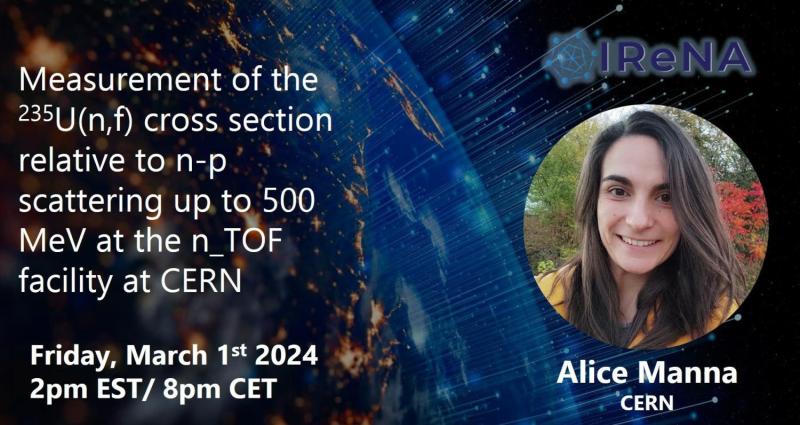Data
Measurement of the 235U(n,f) cross section relative to n-p scattering up to 500 MeV at the n_TOF facility at CERN featuring Alice Manna (CERN)

Hosted by: Denise Piatti (University of Padova)
Neutron-induced fission reactions play a key role in the nucleosynthesis of heavy elements. The description of fission recycling during r-process nucleosynthesis, relies on model predictions of fission reactions. To this end, various models are used in literature for calculating the fission rates and the mass distribution of fission fragments for a number of heavy and highly unstable actinides. In order to provide a reliable description of reaction rates for Th, U and heavier actinides, current efforts are underway for refining models with a comprehensive and self-consistent description of the fission process.
In this respect, new fission data on a variety of actinides are needed, as the predictive power of current models can only by improved by comparison with a large set of experimental results. The 235U(n,f) cross section is one of the most important neutron cross-section standards, and therefore it is recognized as a convenient reference for other reaction cross-section measurements at thermal energy and between 0.15 MeV and 200 MeV. Outside these energy ranges the cross section is either not so well known or not measured yet, as for example above 200 MeV, where evaluations can only rely on theoretical calculations.
With the continuous effort for the improvement of standard cross sections by the International Atomic Energy Agency (IAEA) together with nuclear data evaluators’ teams, the longstanding quest for accurate and reliable 235U(n,f) cross section data turns out to be still pending, for neutron energies above 20 MeV (only 2 data sets are present in the 20-200 MeV energy region). In particular, fission measurements relative to the neutron-proton elastic scattering, which is considered the primary reference for neutron cross section measurements, are still highly requested.
The neutron time-of-flight facility, n_TOF, at CERN, offers the possibility to study neutron-induced reactions thanks to the extremely wide neutron energy spectrum available in its experimental area, from thermal up to 1 GeV. In the recent years, dedicated measurement campaigns were carried out to provide accurate and precise cross section data of the 235U(n,f) reaction, in a low energy region, up to 10 MeV, as well as in the high energy region from 10 MeV to 500 MeV.
The experimental apparatus used in the measurements at high neutron energies, which involved the efforts of several research institutions (INFN, PTB and IPN, in addition to CERN), consisted of three flux and two fission detectors, allowing to simultaneously record the number of neutrons impinging on the 235U samples (incident neutron flux), as well as fission events, as a function of the neutron energy. The neutron flux measurement is based on the neutron-proton elastic scattering reaction, and it exploits the detection of the recoil protons from the n-p reaction in a polyethylene target using three Proton Recoil Telescopes. The fission events have been recorded with a fission ionization chamber, as well as by a parallel plates avalanche counters (PPAC) detector, specifically
designed for operation at n_TOF.
The experimental apparatus and data analysis will be presented, with a focus on the results obtained in the high-energy region, above 200 MeV. A comparison with current model descriptions of the fission process at high neutron energies will be included in the comparison with the experimental results obtained at n_TOF.
